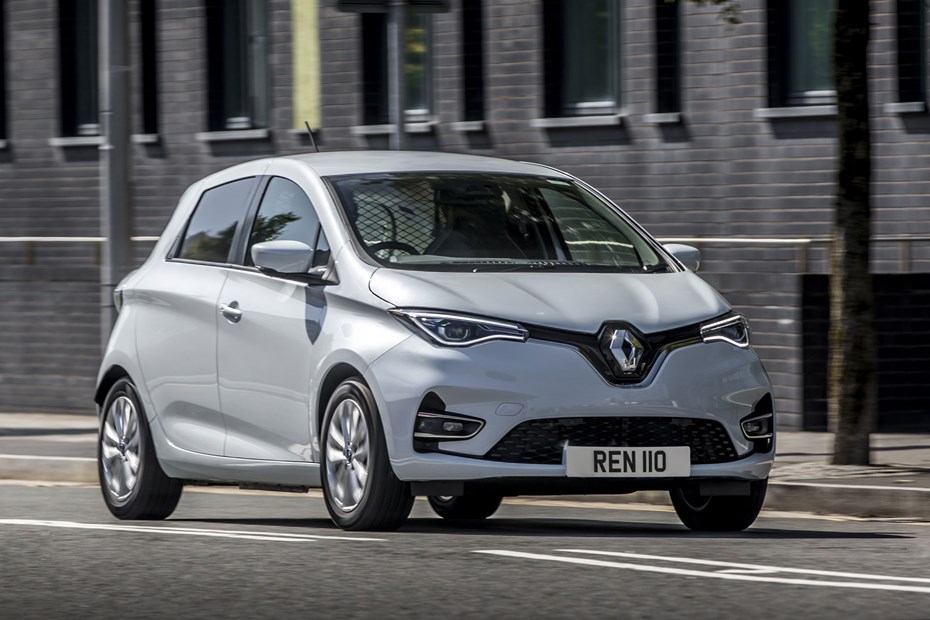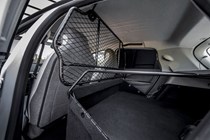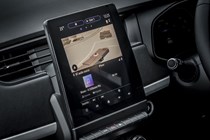UPDATE: We have now driven this new electric van – read our full Renault Zoe Van review.
Renault has revealed a van version of its latest Zoe electric car. To say this is an unusual entrant into the van market would be a massive understatement – but with a claimed driving range of 245 miles per charge, it might just make sense to firms looking for a greener alternative to the Ford Fiesta Van, the only other car-derived van on the market.
Like the car version, the Renault Zoe Van is powered by batteries only and drives its front wheels with a 109hp electric motor. It offers a similar load space to the Fiesta Van, but a significantly lower maximum payload. Whether that matters in a vehicle as small as this will depend on your business.
With a starting price just over £25,000 once the UK government’s plug-in van grant (PIVG) has been included, the Zoe car-derived van costs nearly £10,000 more than an entry-level Fiesta Van. However, it also offers more performance, lower running costs, £0 taxation costs, is expected to hold its value better, and comes with a five-year warranty.
Interested? Keep reading for all the details.
What makes the Renault Zoe into a car-derived van?
The Renault Zoe Van is based on the Renault Zoe passenger car – hence it’s described as a car-derived van. All of the changes are on the inside, so from the outside the van looks just like the car, except for having blanked-off rear side windows.
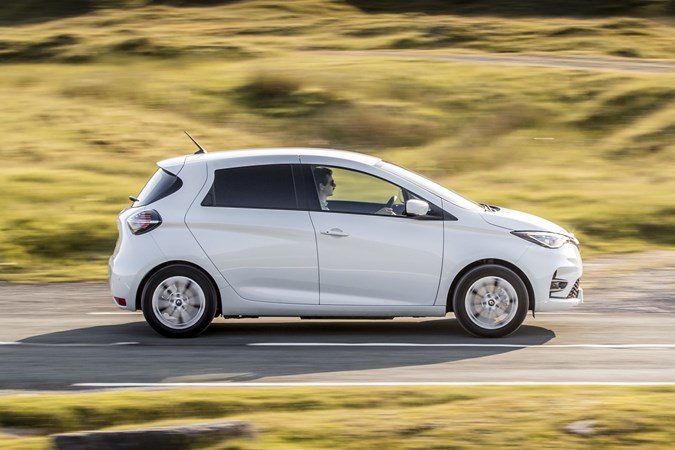
On the inside, everything is also the same as the car for the driver and front passenger. This means you get all the creature comforts of the Zoe car, including digital instruments, a central touchscreen, air-conditioning and cruise control.
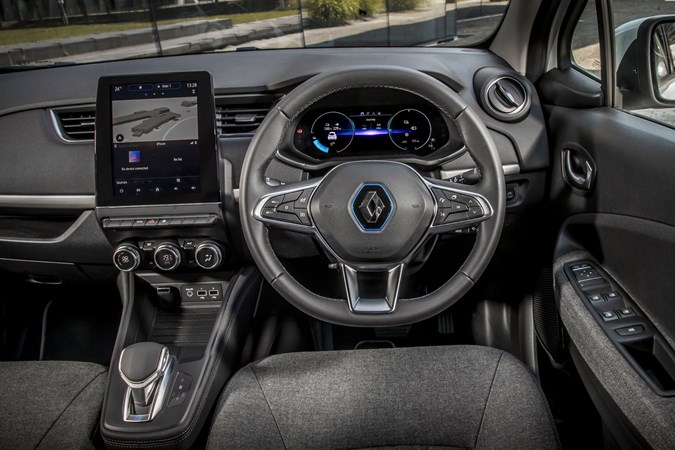
Behind the front seats, however, all of the car stuff is stripped out and a flat load space has been created with a tough rubber floor and mesh bulkhead.
How practical is it as a van?
The resulting load-space is 1,205mm long and up to 1,110mm wide (950mm between the wheelarches), and can be accessed via the rear tailgate and the rear side doors, which open in exactly the same way as they do in the passenger version.
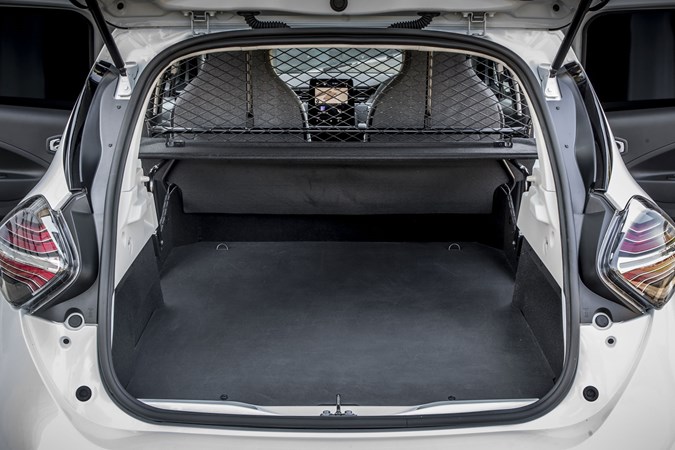
Load volume in the Zoe Van is 1.0 cubic metre – which compares well to the 0.96 cubic metres available in the Fiesta Van.
However, the Fiesta Van trumps the Renault for payload. The Zoe Van’s maximum payload is 387kg for the entry-level Business version, falling to 386kg for the fancier Business+ model; the Fiesta Van can carry 508-530kg, depending on the variant.
On the other hand, how much weight are you realistically going to put in the back of a van of this size?

In addition to the rubber floor and the mesh bulkhead, the Zoe Van also features four load-lashing tie-down points and a full load cover. The rear window remains clear glass as standard, so this last will be useful to keep prying eyes off your gear. Deploying this does halve the useable load volume, though.
What’s the driving range of the Renault Zoe Van?
The Zoe Van gets the same 52kWh battery pack as the Zoe car – which, for reference, is bigger than the 50kWh battery pack fitted in the basic versions of the new Vauxhall Vivaro-e medium electric van.
So you won’t be too surprised to learn that the Zoe Van offers the greatest driving range of any electric van on sale so far, claiming 245 miles using the latest WLTP measuring process. This accounts for some payload but not the full amount, so really load it up and you won’t get that far – but this is the same as any van.
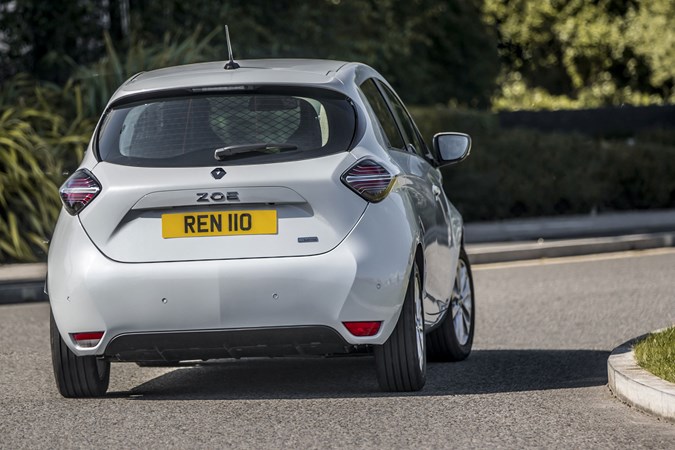
Renault goes a bit further than WLTP and also provides its own real-world estimates for the driving range of its electric vans in winter and summer. In the Zoe Van’s case this works out as 150 miles in the winter and 233 miles in the summer.
All electric vans will have reduced range in the cold, Renault is just commendably honest about it.
How long does it take to charge?
The Zoe Van is compatible with a wide range of charging options, including optional rapid-charging (these models can be identified by the letters RC in their full names).
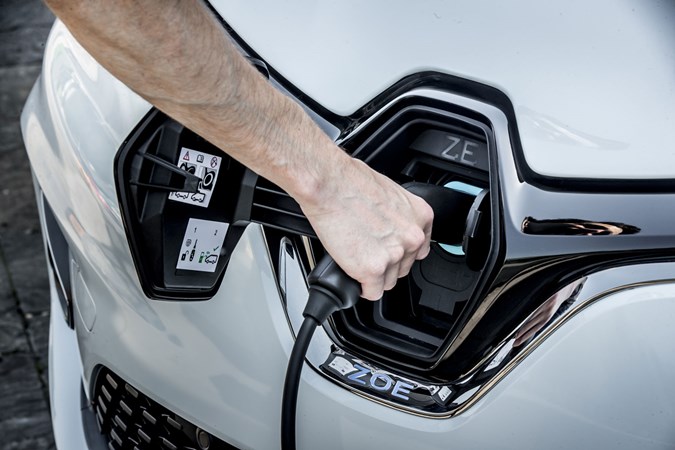
So if you’re prepared to pay the price to use a 50kW public rapid charger you can get an 80% top-up in 70 minutes. On a 22kW charger a full charge takes 3 hours, while a 7kW wallbox – the kind of thing you might have installed at home or office – delivers a full charge in 9 hours 25 minutes.
You can charge the Zoe Van using a three-pin plug, but that takes so long Renault doesn’t even quote a time for it, and is best reserved for emergency or necessity.
How powerful is the Zoe Van and can it tow a trailer?
The Zoe Van’s R110 electric motor produces 80kW (equivalent to 109hp) and 225Nm of torque, enough to snap out 0-62mph in 11.4 seconds – and 0-31mph in 3.9 seconds.
Electric motors are very responsive, so it will certainly feel nippy, especially from low speeds, ideal for where it’s most likely to be used: around town. Top speed is limited to 84mph.
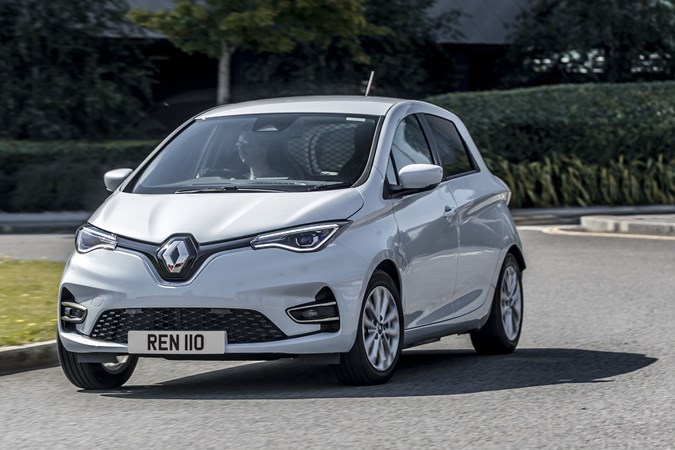
No Renault electric van is presently rated to tow a trailer. You’ll need one of the PSA Group triplets – Vauxhall Vivaro-e, Citroen e-Dispatch, Peugeot e-Expert – if you want an electric van that can manage that.
What’s the standard equipment like?
Very generous. There are two trim levels to choose from, Business and Business+, and here are the highlights:
Renault Zoe Van Business trim standard equipment highlights:
- > 10.0-inch TFT instrument cluster
- > 7.0-inch Easy Link infotainment screen with Apple CarPlay and Android Auto connectivity
- > Manual air-conditioning
- > Electric front windows
- > Keyless entry
- > Electric, heated door mirrors
- > Automatic lights and wipers
- > Full LED headlights
- > Driver and passenger airbags
- > Isofix points for child’s seat on passenger seat
- > Front fog lights
- > Cruise control with speed limiter
- > ZE Voice (low speed pedestrian warning system)
Upgrade to the Renault Zoe Van Business+ and you also get:
- > Satellite-navigation
- > Wireless smartphone charging
- > Rear parking sensors
- > Rear parking camera
- > Recycled seat upholstery
- > Lane Keeping Assist
- > Lane Departure Warning
- > Automatic High/Low Beam
- > Traffic Sign Recognition
- > Climate control
- > Electrically folding door mirrors, finished in body colour
- > 16-inch alloy wheels
In addition to this, the Zoe Van can be upgraded with a Tech Pack, which includes a larger 9.3-inch central screen, front and rear parking sensors, and a rear-view camera.
There’s also a Winter Pack, adding heated seats and a heated steering wheel.
How much does the Renault Zoe Van cost?
The starting price, with the PiVG, is £19,380 basic (excluding VAT) / £25,180 retail (including VAT) – which gets you a Renault Zoe Van Business model without rapid charging. If you do want rapid charging, the equivalent RC version is £20,045 / £26,020 with the grant.
Business+ costs from £20,330 / £26,380 without rapid charging and £20,995 / £27,220 with rapid charging – both after the grant savings.
Road tax (VED) is £0, and there’s no benefit-in-kind (BiK) company car tax on electric vans presently, either. This, together with the low cost of electricity per mile compared with petrol, lower servicing costs and the promise of strong secondhand values for the Zoe Van, should all help keep your running costs down.
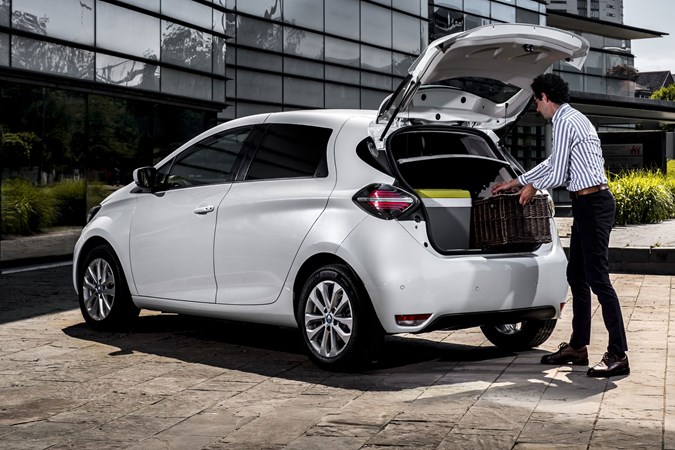
If you need more space or payload than the Zoe Van can offer, it’s worth noting that the Renault Kangoo ZE small electric van actually costs less – but it’s also a much older product with a lower driving range, far less powerful motor and far less inviting cabin.
Pricing for the Vauxhall Vivaro-e starts at £27,723 incidentally, but that’s a much larger van and probably won’t be attractive to the same type of customers.
The Renault Zoe Van is available to order in August 2020, with first deliveries expected in November 2020. It comes with a five-year / 100,000 mile warranty (the first two years have no mileage cap), and the battery components are covered for eight years / 100,000 miles.
Also read:
>> NEW: Our Renault Zoe Van review
>> The Parkers guide to electric vans
>> The best electric vans you can buy now
>> Future electric vans coming soon
Just so you know, we may receive a commission or other compensation from the links on this website - read why you should trust us.


